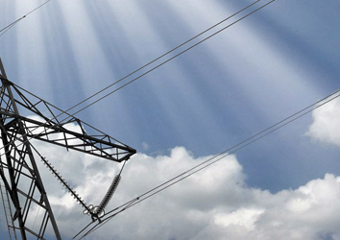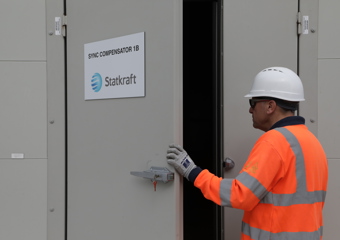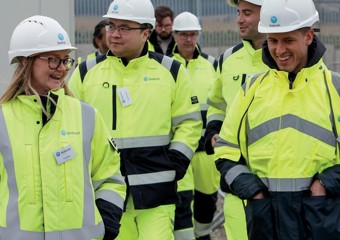
Helping the UK charge ahead with Battery Energy Storage Systems
Statkraft’s Lucy Kent, Head of Greener Grid Parks, explains how the UK can ‘balance the scales’ of the grid with Battery Energy Storage Systems (BESS), and what more is needed to overcome barriers to growth.

Lucy Kent
With the National Energy System Operator (NESO) aiming to operate a zero-carbon electricity system by 2025, there’s never been a more important time to utilise reliable solutions that can help us meet this ambition. To hit this target, fossil fuels are being replaced with renewable energy – such as wind and solar. But given that these are driven by changeable weather, and they don’t come with integrated grid stability services, the transition to renewables needs to come with flexible solutions that step in to ensure there’s always enough power supply to meet demand, and ensure power supply is uninterrupted.
Currently, the UK is heavily reliant on natural gas to balance energy fluctuations and maintain this grid stability. Yet the IPCC warns that fossil fuel emissions must be halved within 11 years if global warming is to be limited to 1.5°C above pre-industrial levels, the target identified as part of the Paris Climate Agreement. If the UK is to achieve its own zero-carbon targets, whilst achieving greater energy independence and the associated benefits, it must reduce its reliance on natural gas.
This is where we see the need to rapidly scale up low-carbon energy storage solutions, with batteries (or BESS) being a crucial component in the UK’s future energy mix.
BESS explained
Battery storage technology is one of the essential tools that helps keep the power on as we move towards zero-carbon electricity. They work in two ways; 1) for grid stabilisation, and 2) for supplying power to the grid when there are low levels of wind and sun (or storing power when the opposite is true).
Similarly to synchronous compensators or turbine-powered plants, batteries can be used to stabilise the frequency of the power grid. BESS are a quick solution for delivering large amounts of power to the grid, discharging electricity in a fraction of a second to prevent situations such as power outages. Used like this, they stabilise the grid and ensure the lights stay on uninterrupted.
Another function of BESS is seen at times of low electricity supply to the network or times of high demand, resulting in a lot of strain on the electricity grid. To reduce that load, BESS are necessary to balance the scales by storing excess energy from the grid ready to discharge back to the electricity network during times of low energy generation - such as at night with no irradiance or on a windless day. BESS can also step in during periods of high demand, such as during a heat wave when everyone cranks up the air conditioning.
The power stored and then exported from the BESS will increasingly be from renewables; stored at times when renewable power generation is high, but demand is low. As well as improving the proportion of zero carbon power of the grid, and offering stability services, this is an important benefit of BESS as they reduce the need for costly curtailment. It can happen that generation from a renewable source, such as wind or solar power, is intentionally paused. This tends to occur when there is an excess of electricity production from renewables that cannot be accommodated or efficiently utilised within the existing electrical grid infrastructure. For instance, wind generation is often best during the night when demand on the grid is low. So, if all the wind farms across the UK were generating a lot of power but there is no need for it, rather than pausing production, NESO could instruct BESS operators to store the excess wind electricity ready to release when needed.
The energy is stored as chemical energy; lithium-ion batteries are the dominant technology for such applications. Lithium-ion batteries are commonly found in electronic devices, including mobile phones and electric vehicles, and have become increasingly popular in renewable energy storage systems due to their ability to store energy efficiently, cheaply, and without significant loss.
These batteries operate on a simple principle: during charging, electrical energy is converted into chemical energy as lithium-ions move from the positive electrode (cathode) to the negative electrode (anode) through an electrolyte. During discharging, this process reverses as the lithium-ions move back to the cathode, releasing the stored chemical energy as electrical energy. This electrochemical process, driven by the movement of electrons between the battery’s poles, allows excess energy to be stored and then released when needed, ensuring a reliable and consistent electricity supply.
The core components of BESS include the batteries themselves, a Battery Management System (BMS) that monitors and manages battery performance to ensure safety and efficiency 24/7, and a Power Conversion System (PCS) that converts alternating current (AC) from the grid or renewable sources to direct current (DC) for battery charging, and back to AC for discharge into the grid. Control systems and software coordinate these components to optimise performance, manage energy flows, and ensure seamless integration with the grid.
BESS are typically housed in modular units resembling shipping containers and can be strategically located near power plants, substations, or renewable energy sites such as solar farms and wind farms. This co-location optimises space and infrastructure, can reduce transmission losses, and enhances the overall efficiency of the energy system.
Keeping up the pace
In its 2024 Future Energy Scenario, the National Energy System Operator, forecasts that Britain could need up to 65 GWh of BESS by 2050 - more than a 10-fold increase from the 5.8 GWh we have today. But there are obstacles in the way that need to be cleared.
Limited grid capacity and long connection dates are a key barrier to realising the potential of BESS. As an example, in 2023 we were told that a 500 MW BESS project that we’re developing would have a connection date of 2030, despite us having this project ready to connect by 2026 – delaying the project by four years. We have now been told that the connection date has been pushed back even further to 2037 – an eleven-year delay. Grid access is an issue affecting the entire renewable industry in the UK and needs some urgent focus.
The new Government has the mission to make Britain a clean energy superpower, and so we are calling for ministers to maintain their focus on addressing slow grid connections and to carefully monitor the progress of the regulator and system operators in delivering on the commitments they have made. Bold action is necessary to reduce the grid connection queue, rather than just stopping it from increasing, and it is necessary to move to a genuinely First Ready First Connect process that allows the active promotion of projects across a range of technologies.
Statkraft’s Greener Grid Parks
Statkraft is contributing to the growth of BESS systems with our Greener Grid Parks. These are units usually located near substations that contain technology, such as BESS or synchronous compensators or both, that ensure the electricity grid remains stable as we increase the amount of renewable energy in the network. By actively developing Greener Grid Parks and increasing renewables, Statkraft is supporting NESO to deliver their target of operating a zero-carbon electricity system by 2025, increasing the UK’s energy independence and reducing costs to consumers.
Statkraft has commissioned two Greener Grid Parks to date, with four currently under construction and another ten in development across the UK, representing 2 GW. These will enable energy from renewable sources to be stored during times of low demand and dispatched at times of peak electricity demand. Currently, the BESS Greener Grid Parks developed by Statkraft are intended for short-term storage and typically have a duration of two hours. These are essential for temporary storage for later in the day, or for quickly delivering large amounts of power to the grid to maintain stability of the network and prevent blackouts.
Powering a green solution
With renewable energy rapidly increasing, we must find solutions that provide the necessary flexibility without relying on fossil energy sources. Huge progress has already been made regarding the increasing number of grid-scale battery storage projects in the UK, of which Statkraft is a significant contributor.
At the same time, we must recognise that there are areas where further progress needs to be made. If we want to achieve NESO's target of a zero-carbon electricity system by 2025, we need more investment in large-scale battery storage facilities – and we need it fast.
Related pages

Grid Services: Innovative solutions to stabilise our electricity system
Statkraft are market leaders in delivering innovative projects that ensure the reliability of our electricity supply. We explain why grid stability is crucial in the transition to a net zero electrici...
Read more
Greener Grid Parks
As Great Britain generates increasing amounts of electricity from renewable sources, storage and innovative grid management is an essential component of a successful transition to a Net Zero energy...
Read more

Statkraft’s new Liverpool scheme helps to deliver a greener and stable electricity grid in Great Britain
The site is part of £1.3bn of investment in the UK’s renewable energy infrastructure made by Statkraft since 2006, and is the second Greener Grid Park to become operational
Read more

The role of BESS in the UK’s energy transition
The UK Government has set ambitious goals for transforming our electricity grid, aiming to fully decarbonise the power sector by 2035.
Read more